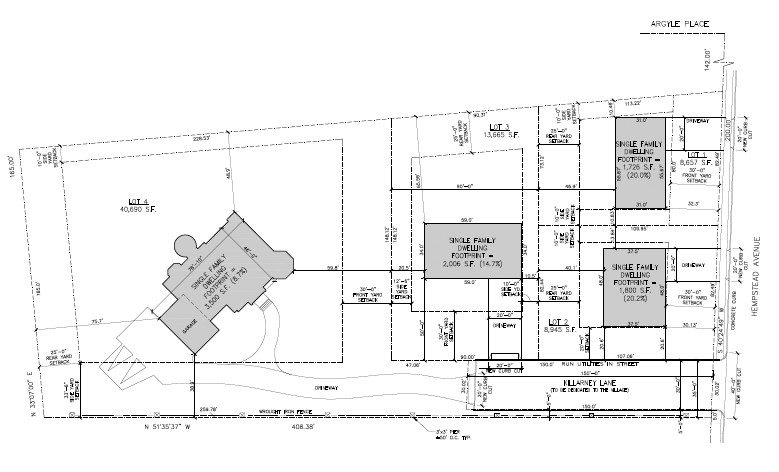Residents bash variance request by Hempstead Ave. homeowner
RVC Zoning Board of Appeals expected to vote on case June 21
“I wasn’t going to bring this up,” said Robert Schenone, chairman of Rockville Centre’s Board of Appeals. “I’m going to get in a lot of trouble for this.”
The dozens in attendance, many of who had gathered at Village Hall on June 7 to voice their opposition for proposed plans to subdivide a 1.75-acre property at 220 Hempstead Avenue, listened intently as Schenone paused.
“Public opinion is not necessarily always correct,” he continued, “…because it’s emotional.”
Schenone’s frankness came more than an hour into a nearly three-hour meeting, during which residents approached the podium one by one to speak against a zoning variance requested by Jim O’Reilly, who owns the 19th century home next to St. Mark’s United Methodist Church.
His plan includes knocking down the 1898 home — the church’s former parsonage — and splitting the property into four single-family plots, as well as building Killarney Lane, a road perpendicular to Hempstead Avenue — to become a public street after being donated to the village — that would turn into a driveway for the back house, where O’Reilly would live. Village code requires that each house have at least 80 feet of frontage on public roads, which the two back houses do not.
Residents cited the house’s historical value, as well as overcrowding in the village and increased traffic on Hempstead Avenue in their arguments against the board granting the variance.
“We moved to Rockville Centre to have a wonderful neighborhood, not to be overbuilt,” said Harvard Avenue resident Maureen Deverna. “Enough! We’re coming to you in these meetings to ask for your help, we’re getting nothing in return, and I’m going to cry.” Then she did, before walking back to her seat.
But like a teacher attempting to set straight an unruly class, Schenone repeatedly explained to the crowd that much of the opinions being shared were ones to be expressed to the village’s planning board, and that the zoning board is only looking at the variance for the frontage.
“We can only look at the application that’s before us, and we have to have blinders on for the outside, and that’s what the planning board is for in this case,” Schenone said. “When a case is going from this board to another board, we can’t overstep their authority. We have to be very narrow.”
Though locals shot back that a variance was the first step in the process of making the subdivision possible, John A. Matthews, counsel to the board, explained that granting a street frontage variance for the two houses would allow the road to be built as is, but the planning board could still opt not to go that route.
“He could build these four houses with a longer road and a cul-de-sac without a zoning variance, but he still needs planning board approval for the subdivision,” Matthews said.
O’Reilly’s attorney, Chris Brown, told the board that other options to divide the property, some of which would not have required a zoning variance, would have overburdened the site, which the applicant, who would live there after the planned development, wanted to avoid. He added that a cul-de-sac, or dead-end street, would force O’Reilly to destroy oak trees, and would most likely alter the plan to include six homes, instead of four.
“I haven’t heard any actual evidence of how the street frontage variances themselves would cause a detriment to the nature and character of the neighborhood,” Brown said. “I would submit to you that it’s almost impossible to show that, because the lots would be nuanced not on an existing street, back in their own neighborhood, and would only really affect each other.”
The case was originally scheduled to be heard by both the planning and zoning boards at the same time, but was later separated, according to Zoning Board Secretary Patrick O’Brien. It was then resubmitted to the county after a May 24 zoning board meeting — during which residents similarly bashed the proposal — was adjourned.
On June 8, the Nassau County Planning Commission granted “local determination” for the case — meaning the zoning board can act as they deem appropriate — but recommended a cul-de-sac. With the county’s approval to proceed, the zoning board had said that it would vote on the variance during its next public works session, which is June 21.
If the zoning board approves the variance, the case would move forward to the village’s planning board.
“The detriment caused by this variance I would submit to you is nothing,” Brown concluded, “especially when it’s compared to the detriment that would be caused from another site plan that wouldn’t require this sort of relief from the board.”






